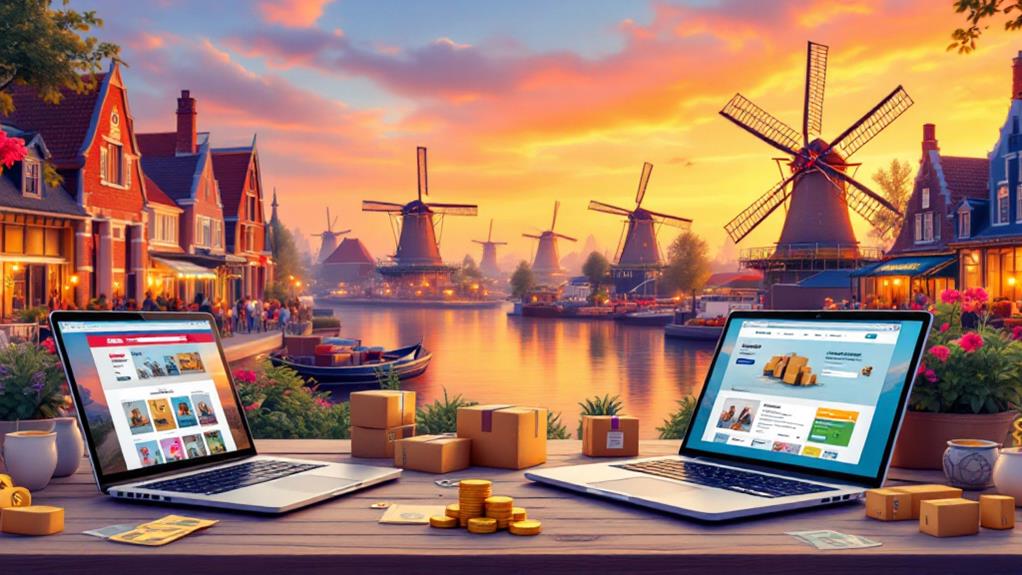Dropshipping in the Netherlands is profitable, thanks to the high internet penetration and strong e-commerce infrastructure. The tech-savvy Dutch population appreciates efficiency and seamless experiences, favoring this retail model. Furthermore, the advanced logistics network supports quick delivery, essential due to local consumer expectations. Economic stability and high disposable incomes provide a solid customer base, while multilingualism aids expansion across Europe. However, compliance with local regulations, such as GDPR and VAT laws, is vital. By leveraging local payment methods like iDEAL and emphasizing sustainability, you can enhance customer satisfaction and competitiveness, paving the way for further insights and strategies.
Table of Contents
ToggleUnderstanding the Dutch E-Commerce Market
The Dutch e-commerce market, a rapidly evolving landscape, offers exciting opportunities for businesses looking to expand online. With a population of over 17 million, the Netherlands boasts a high internet penetration rate, reaching approximately 96%. This connectivity provides a solid foundation for online shopping.
Consumers in the Netherlands are tech-savvy, with a preference for digital solutions, making the market ripe for e-commerce ventures. The drop shipping model is particularly appealing due to its low startup costs and flexibility, allowing businesses to test various products without significant financial risk.
You should be aware that Dutch consumers value efficiency and convenience, favoring platforms that offer seamless user experiences and diverse payment options. iDEAL, a popular payment method in the Netherlands, accounts for over half of all online transactions, so integrating it into your e-commerce platform is essential. Dutch shoppers also appreciate fast delivery, with many expecting delivery within one to two days.
Furthermore, sustainability is a growing concern among Dutch consumers, influencing their purchasing decisions. Businesses that prioritize eco-friendly practices, such as using recyclable packaging and offering sustainable products, can gain a competitive edge.
Additionally, the Dutch e-commerce market is characterized by a high level of competition, with major players like Bol.com and Coolblue dominating. Success requires strategic positioning and a deep understanding of local consumer behavior.
Advantages of Dropshipping in the Netherlands
Consider diving into the dropshipping model in the Netherlands, where a robust infrastructure and tech-savvy population create fertile ground for success.
The country's advanced logistics network guarantees efficient handling of goods, benefiting from its strategic location as a European hub. This allows you to reach customers quickly, enhancing their shopping experience and potentially increasing repeat business.
The Netherlands boasts a high internet penetration rate, with over 95% of the population online. This digital presence supports e-commerce growth, providing a ready market for your dropshipping business.
Dutch consumers are comfortable with online shopping, which aligns well with the dropshipping model, where quick transactions and minimal inventory risk are key advantages.
Moreover, the Netherlands has a strong economy and a high disposable income, which means consumers are willing to spend on a variety of products. This economic stability provides a reliable customer base.
Additionally, the country's multilingual population can facilitate expansion beyond Dutch borders, allowing you to tap into broader European markets seamlessly.
Navigating Local Regulations
While the Netherlands offers numerous advantages for dropshipping, it's important to understand the local regulations that govern this business model. As a dropshipper, you need to familiarize yourself with the Dutch legal landscape to guarantee compliance.
Begin by registering your business with the Dutch Chamber of Commerce (KvK). This step legitimizes your operations and is mandatory for all businesses in the Netherlands.
Next, consider the European Union's General Data Protection Regulation (GDPR). This regulation affects how you handle customer data, requiring you to protect personal information diligently. Make sure your privacy policies are up-to-date and transparent, as violations can lead to hefty fines.
You'll also need to navigate the Value Added Tax (VAT) system. The Netherlands imposes a standard VAT rate of 21%, which you must collect on sales within the EU. It's essential to understand when and how to charge VAT, especially if you sell to non-EU countries, as different rules may apply.
Lastly, familiarize yourself with import regulations, as dropshipping often involves international suppliers. You may need to deal with customs duties and restrictions, depending on the products you sell.
Understanding these aspects will help you avoid legal pitfalls and streamline your operations.
Consumer Behavior and Preferences
Understanding consumer behavior and preferences in the Netherlands can make or break your dropshipping business. Dutch consumers are known for valuing sustainability and quality. They prefer products that are eco-friendly and ethically produced. This means you should carefully select suppliers who prioritize sustainable practices, as this aligns with local values.
Furthermore, Dutch shoppers appreciate transparency, so providing detailed product information and clear pricing is essential. You also need to reflect on the strong digital presence in the Netherlands. Many people research products online before purchasing, comparing prices and reviews. Having a well-optimized online store with user-friendly navigation and reliable customer reviews can greatly impact your business's success.
Social media platforms are influential in the Dutch market, so effective social media marketing can enhance brand visibility and attract more customers. Payment preferences are another critical aspect. Dutch consumers often use local payment methods like iDEAL, a popular online banking system. Ensuring your store supports these payment options can increase conversion rates.
In addition, offering reliable customer service, including prompt responses to inquiries and efficient handling of returns, can help build trust and encourage repeat business. By understanding these consumer preferences, you can tailor your dropshipping strategy to meet local demands effectively.
Logistics and Supply Chain Considerations
Building on the understanding of Dutch consumer preferences, optimizing your logistics and supply chain is essential for dropshipping success in the Netherlands. The country's efficient infrastructure, including its ports and road networks, supports swift and reliable delivery, a critical factor when catering to Dutch consumers who value speed and efficiency.
You should establish partnerships with suppliers who can guarantee fast processing and shipping times; this cooperation is key to meeting customer expectations.
Consider using local fulfillment centers or warehouses, which can greatly reduce delivery times within the Netherlands. This strategy not only enhances customer satisfaction but also reduces shipping costs, making your pricing more competitive.
Additionally, familiarize yourself with local shipping carriers, as they often offer better rates and services tailored to Dutch regions.
Pay attention to inventory management, ensuring that your supply chain can adapt to fluctuations in demand. Implementing automated systems can streamline order processing, minimize errors, and improve the overall customer experience.
Finally, stay informed about customs regulations and taxes, as seamless navigation of these factors will prevent delays and additional costs.
Overcoming Common Challenges
Maneuvering the dropshipping landscape in the Netherlands often presents unique challenges that require strategic solutions. One significant hurdle is managing customer expectations around shipping times. Since many Dutch consumers expect fast delivery, delays can lead to dissatisfaction. To mitigate this, you should clearly communicate estimated delivery times and consider partnering with suppliers who offer quicker shipping options.
Another challenge is dealing with local competition. The Dutch market is competitive with many businesses vying for the same audience. To stand out, focus on a niche market, guaranteeing that your products are unique or offer added value compared to others.
Additionally, understanding local consumer preferences is essential, as Dutch consumers often prioritize sustainability and ethical sourcing.
Complying with EU regulations is also critical. These rules cover everything from data protection to product safety, and non-compliance can result in hefty fines. Familiarize yourself with these regulations and confirm your business practices align with them.
Lastly, currency fluctuations can impact profit margins. Since dropshipping often involves international transactions, keep an eye on exchange rates and adjust your pricing strategy accordingly to protect your profits.
Strategies for Success in the Dutch Market
To thrive in the Dutch dropshipping market, three key strategies can set you apart.
First, focus on localization. Understanding Dutch consumer preferences is essential. The Dutch value sustainability and quality, so sourcing environmentally friendly products can increase your appeal. Use local payment methods like iDEAL to build trust with customers, ensuring smoother transactions.
Second, consider strategic partnerships. Collaborate with reliable suppliers who can guarantee fast shipping and quality products. This minimizes the risk of returns and enhances customer satisfaction.
Building strong relationships with suppliers also allows you to negotiate better terms, potentially increasing your profit margins.
Lastly, invest in effective marketing strategies. Utilize social media platforms popular in the Netherlands, such as Instagram and Facebook, to reach your target audience.
Incorporate Dutch language and cultural references in your marketing campaigns to connect with local consumers on a deeper level. Analyze data to understand which strategies yield the best results, adjusting your approach as necessary.
Frequently Asked Questions
What Are the Most Popular Product Niches for Dropshipping in the Netherlands?
You're curious about popular dropshipping niches in the Netherlands. Focus on health and wellness, eco-friendly products, smart home gadgets, and fashion accessories. These categories resonate with Dutch consumers and can boost your business's appeal and profitability.
How Does the Dutch VAT System Affect Dropshipping Profitability?
You need to understand the Dutch VAT system because it directly impacts your dropshipping profitability. Register for VAT, charge the appropriate rate, and guarantee compliance. This system can increase costs but proper management keeps your business profitable.
Are There Any Dutch-Specific Dropshipping Platforms or Tools Available?
You'll find several Dutch-specific dropshipping platforms like Orderchamp and Channable. They're designed to streamline your operations with local suppliers and optimize your product listings, making it easier to tap into the Netherlands market effectively.
What Are the Trends in Dutch E-Commerce That Impact Dropshipping Success?
You're seeing a surge in mobile shopping, sustainability focus, and personalized experiences in Dutch e-commerce. Embrace these trends by optimizing your store for mobile, offering eco-friendly products, and personalizing customer interactions to boost your dropshipping success.
How Do Dutch Consumers Perceive Dropshipping Businesses Compared to Traditional Retailers?
You might find that Dutch consumers view dropshipping businesses with skepticism due to delivery times and customer service concerns. However, they're open to trying them if you offer competitive prices, quality products, and reliable after-sales support.


